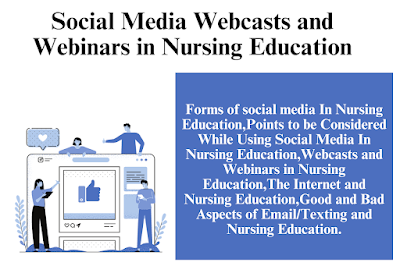The Social Media Webcasts and Webinars in Nursing Education. Education – Social media enables unlimited learning and allows the use of time and space for educational content. Nurses can access content that supports different learning styles anytime, anywhere. An asynchronous approach supports this.
Social media provides nurses with a forum to network, collaborate, and advance the nursing profession. Its power allows nurses to express their opinions, share valuable knowledge, and contribute to healthcare reform and public education.
You can discuss issues that only other caregivers understand, share ideas, and offer support. Follow the American Nurses Association on Facebook, LinkedIn, or Instagram to stay informed on issues important to nurses.
What are Social Media Webcasts and Webinars in Nursing Education
Nurses and healthcare professionals increasingly use social media platforms such as Facebook, Twitter, and YouTube for educational purposes:
- Facebook: A popular platform used by nursing organizations and healthcare professionals for networking, sharing resources, and providing updates on health-related topics. Healthcare consumers also use Facebook to share their healthcare experiences.
- Twitter: Offers free microblogging to share short, timely updates (tweets). It is used in nursing education for professional discussions, sharing healthcare news, and updates from conferences.
- YouTube: A video-sharing platform where users can view and share videos on medical procedures, health education, and nursing techniques. It offers visual learning and reaches a wide audience, making it ideal for education.
These platforms provide various educational tools, allowing users to connect, learn, and share information globally.
Points to be Considered While Using Social Media in Nursing Education
When using social media for nursing education, it is crucial to be aware of potential risks:
- Privacy and Confidentiality: Nurses should avoid sharing any patient-related information or pictures that could violate privacy laws, such as HIPAA.
- Professional Boundaries: Maintaining a clear line between personal and professional use of social media is critical to avoid blurring boundaries with patients.
- Public Information: Anything shared on social media can be widely distributed, so nurses must ensure that all posts adhere to ethical guidelines and professional standards.
- Misinformation: Social media platforms are prone to the spread of misinformation. Nurses must rely on credible sources and verified information when sharing health education content.
Webcasts and Webinars in Nursing Education
Webcasts and webinars are powerful tools for nursing education, offering interactive and engaging learning experiences:
- Webcasts: These are live broadcasts over the internet that allow audio and/or video presentations. They are commonly used for educational lectures, demonstrations, or workshops. Interaction is typically limited to viewing and listening.
- Webinars: A more interactive version of webcasts, webinars allow participants to engage in live discussions, often combining presentations with Q&A sessions. Participants can join via telephone or computer, making them ideal for group learning.
Guidelines for Successful Webinars:
- Plan and publicize in advance: Ensure the audience is aware of the event weeks or months ahead.
- Upload materials and do a test run: Prepare slides or media before the event to ensure everything runs smoothly.
- Ensure adequate technical support: Have staff ready to assist with both the presentation and technical issues.
- Follow up: Engage participants with post-webinar surveys or evaluations to gather feedback.
The Internet and Nursing Education
The Internet serves as a vast educational resource for nursing, offering:
- E-learning platforms: Many nursing programs offer courses and certifications through online platforms, allowing nurses to learn at their own pace.
- Online forums: Nursing professionals can join discussions, ask questions, and exchange ideas on health-related topics.
- Email communication: Allows nurses and patients to communicate asynchronously, enhancing post-care follow-up and education.
Good and Bad Aspects of Email/Texting in Nursing Education
Email and texting offer convenient, quick communication tools but come with their advantages and drawbacks:
Good Aspects:
Asynchronous communication: Emails can be sent and read at convenient times, offering flexibility.
Written records: Both emails and text messages provide a record of communication, which can be referred to later.
Efficiency: These communication methods allow for timely updates, appointment reminders, or follow-up instructions.
Bad Aspects:
Privacy and security: Both emails and texts can be compromised if not properly encrypted or password-protected. Healthcare providers must ensure compliance with privacy laws such as HIPAA.
Delayed responses: Since email and texting rely on asynchronous communication, patients may experience delays in receiving responses to urgent queries.
Lack of context: Without visual or auditory cues, electronic communication can sometimes lead to misunderstandings or lack of clarity in conveying emotions or urgency.
Overall, social media, webcasts, webinars, and digital communication tools like email and texting have become integral in nursing education. However, their effectiveness depends on thoughtful, ethical usage and a strong understanding of the potential risks and benefits.
Read More:
https://nurseseducator.com/didactic-and-dialectic-teaching-rationale-for-team-based-learning/
https://nurseseducator.com/high-fidelity-simulation-use-in-nursing-education/
First NCLEX Exam Center In Pakistan From Lahore (Mall of Lahore) to the Global Nursing
Categories of Journals: W, X, Y and Z Category Journal In Nursing Education
AI in Healthcare Content Creation: A Double-Edged Sword and Scary
Social Links:
https://www.facebook.com/nurseseducator/
https://www.instagram.com/nurseseducator/

1 thought on “Social Media Webcasts and Webinars in Nursing Education”